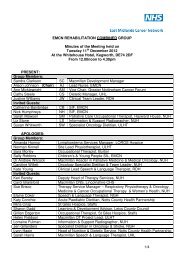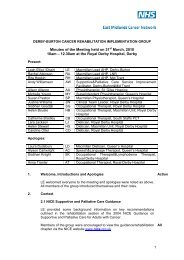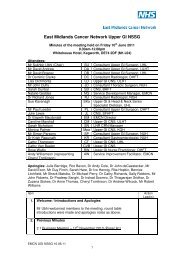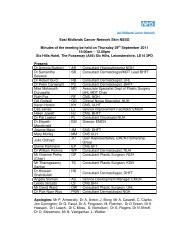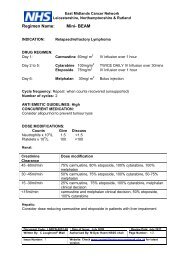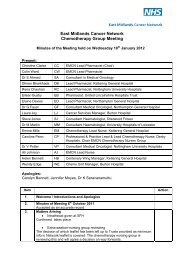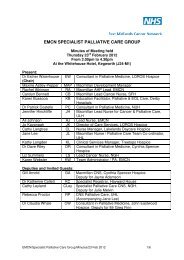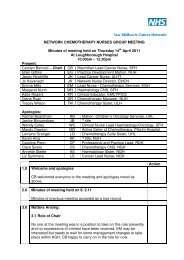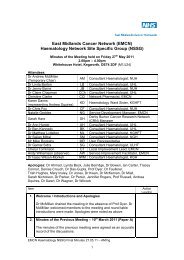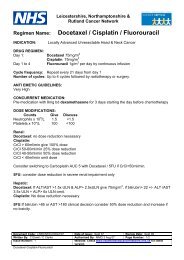Dosage Adjustment for Cytotoxics in Hepatic Impairment
Dosage Adjustment for Cytotoxics in Hepatic Impairment
Dosage Adjustment for Cytotoxics in Hepatic Impairment
Create successful ePaper yourself
Turn your PDF publications into a flip-book with our unique Google optimized e-Paper software.
<strong>Dosage</strong> <strong>Adjustment</strong> <strong>for</strong> <strong>Cytotoxics</strong> <strong>in</strong> <strong>Hepatic</strong><br />
<strong>Impairment</strong><br />
January 2009
<strong>Dosage</strong> <strong>Adjustment</strong> <strong>for</strong> <strong>Cytotoxics</strong> <strong>in</strong> <strong>Hepatic</strong> <strong>Impairment</strong><br />
This table is a guide only. Pharmacok<strong>in</strong>etic, Summary of Product Characteristics (SPC), relevant pharmaceutical company data and various references have been<br />
reviewed <strong>for</strong> each drug. From this <strong>in</strong><strong>for</strong>mation, a recommendation has been suggested. Input of the full cl<strong>in</strong>ical picture of the patient should always be taken <strong>in</strong>to<br />
account. If a patient is follow<strong>in</strong>g a specific cl<strong>in</strong>ical trial or protocol, it is advisable to follow the associated dose modifications.<br />
The reference ranges <strong>for</strong> UCL Hospitals NHS Trust are as follows:<br />
• Bilirub<strong>in</strong>: 3 - 17 μmol/L<br />
• Alkal<strong>in</strong>e phosphatase (ALP): 0 – 455 U/L<br />
• Alan<strong>in</strong>e transam<strong>in</strong>ase (ALT): 8 – 63 U/L<br />
• Aspartate transam<strong>in</strong>ase (AST): 5 – 40 IU/L<br />
Please note that reference ranges will vary from hospital to hospital and this should be taken <strong>in</strong>to account when <strong>in</strong>terpret<strong>in</strong>g the data.<br />
Drug Pharmacok<strong>in</strong>etics Available In<strong>for</strong>mation Recommendation<br />
Alemtuzumab<br />
t 1 / 2 23 – 30 hours.<br />
Serum concentration rise<br />
corresponds with reduction <strong>in</strong><br />
malignant lymphocytosis. Different<br />
pharmacok<strong>in</strong>etic properties may be<br />
related to different tumour burden<br />
and distribution. Alemtuzumab is<br />
primarily metabolised<br />
<strong>in</strong>tracellularly.<br />
SPC (Bayer 2008)– No studies have been conducted <strong>in</strong> patients with hepatic<br />
impairment.<br />
Scher<strong>in</strong>g – No <strong>in</strong><strong>for</strong>mation, but the drug is cleared <strong>in</strong>tracellularly and there<strong>for</strong>e<br />
unlikely to require reduction.<br />
BC Cancer Agency – No <strong>in</strong><strong>for</strong>mation found<br />
Cl<strong>in</strong>ical decision but unlikely to<br />
require a reduction.<br />
Amsacr<strong>in</strong>e<br />
Amsacr<strong>in</strong>e is extensively<br />
metabolised <strong>in</strong> the liver. The<br />
pr<strong>in</strong>cipal metabolites, via<br />
microsomal oxidation, are much<br />
more cytotoxic than the parent<br />
drug. Excretion is via the bile.<br />
>50% excreted <strong>in</strong> faeces with<strong>in</strong> 2<br />
hours; 35% <strong>in</strong> ur<strong>in</strong>e<br />
SPC (Goldshield 2005) – <strong>for</strong> patients with impaired liver function, reduce dose<br />
by 20-30% (to 60-75mg/m2 per day).<br />
BC Cancer Agency – if bilirub<strong>in</strong> 26-51μmol/L, give 40% of usual dose. If<br />
bilirub<strong>in</strong>> 51 μmol/L then reduce further or omit.<br />
AML 17 – if bilirub<strong>in</strong> >34μmol/L give 60% dose.<br />
If bilirub<strong>in</strong> >34μmol/L give 60%<br />
dose.<br />
Arsenic Trioxide<br />
Arsenic is stored ma<strong>in</strong>ly <strong>in</strong> liver,<br />
kidney, heart, lung, hair and nails.<br />
Trivalent <strong>for</strong>ms of arsenic are<br />
methylated <strong>in</strong> humans and mostly<br />
excreted <strong>in</strong> the ur<strong>in</strong>e.<br />
SPC (Cephalon 2008) – the safety of the drug <strong>in</strong> patients with hepatic<br />
impairment has not been studied.<br />
Johns et al 1 – A phase I study was conducted <strong>in</strong> 23 subjects with unresectable,<br />
carc<strong>in</strong>oma with vary<strong>in</strong>g degrees of hepatic dysfunction. Doses were escalated<br />
from 0.25mg/kg to 0.5mg/kg and then by <strong>in</strong>crements of 0.5mg/kg. The authors<br />
found the drug was well tolerated <strong>in</strong> this group of subjects.<br />
UCLH - <strong>Dosage</strong> <strong>Adjustment</strong> <strong>for</strong> <strong>Cytotoxics</strong> <strong>in</strong> <strong>Hepatic</strong> <strong>Impairment</strong> (Version 3 - updated January 2009) Page 2 of 19<br />
Cl<strong>in</strong>ical decision – unlikely to require<br />
reduction.
Drug Pharmacok<strong>in</strong>etics Available In<strong>for</strong>mation Recommendation<br />
ATRA (tret<strong>in</strong>o<strong>in</strong>)<br />
Azacitad<strong>in</strong>e<br />
Bevacizumab<br />
Bexarotene<br />
Bleomyc<strong>in</strong><br />
Bortezomib<br />
After an oral dose of radiolabelled<br />
tret<strong>in</strong>o<strong>in</strong>, about 60% of the<br />
radioactivity was excreted <strong>in</strong> ur<strong>in</strong>e<br />
and about 30% <strong>in</strong> faeces. The<br />
metabolites found <strong>in</strong> ur<strong>in</strong>e were<br />
<strong>for</strong>med by oxidation and<br />
glucuronidation.<br />
Azacitad<strong>in</strong>e undergoes rapid<br />
elim<strong>in</strong>ation. The route of<br />
elim<strong>in</strong>ation requires further study<br />
but the drug appears to undergo<br />
hepatic metabolism with excretion.<br />
Excretion of unchanged drug and<br />
metabolites is via the kidneys. The<br />
activity of metabolites is unknown.<br />
Term<strong>in</strong>al half-life 19-20 days.<br />
Male patients and those with a<br />
higher tumour burden have a<br />
greater clearance than female<br />
patients. The drug does not rely<br />
primarily on elim<strong>in</strong>ation through<br />
kidneys or liver.<br />
Metabolised by oxidation via<br />
CYP450 3A4 and glucuronidation.<br />
Less than 1% excreted <strong>in</strong> the ur<strong>in</strong>e.<br />
t½ 2-4 hours.<br />
Rapid distribution to body tissues<br />
(highest concentration <strong>in</strong> sk<strong>in</strong>,<br />
lungs, peritoneum & lymph).<br />
Inactivation takes place primarily <strong>in</strong><br />
the liver. ~ 2/3 of drug are excreted<br />
unchanged <strong>in</strong> the ur<strong>in</strong>e, probably by<br />
glomerular filtration.<br />
Metabolised by oxidation via<br />
CYP450 3A4 and 2C9. Small<br />
amount excreted <strong>in</strong> the ur<strong>in</strong>e.<br />
SPC (Roche 2008) – Due to limited <strong>in</strong><strong>for</strong>mation reduce dose to 25mg/m 2 <strong>in</strong><br />
patients with hepatic impairment.<br />
BC cancer agency – 25mg/m 2 is recommended <strong>in</strong> patients with hepatic<br />
impairment as no studies have been done.<br />
Pharmion – In the 3 NCI studies <strong>in</strong>volv<strong>in</strong>g azacitad<strong>in</strong>e there was no significant<br />
<strong>in</strong>crease <strong>in</strong> adverse reactions <strong>in</strong> patients with hepatic impairment compared with<br />
those with normal hepatic function. However the drug should be used with<br />
caution as it is metabolised by hepatic enzymes. In addition there is also some<br />
limited data suggest<strong>in</strong>g that azacitad<strong>in</strong>e may be hepatotoxic <strong>in</strong> patients with<br />
severe pre exist<strong>in</strong>g hepatic impairment.<br />
The start<strong>in</strong>g dose <strong>for</strong> the drug is 75mg/m 2 SC <strong>for</strong> 7 days this is regardless of<br />
hepatic function and no dose adjustments should be made. The dose is titrated<br />
up to 100mg/m 2 if no toxicity occurs and benefit has not been seen with the<br />
start<strong>in</strong>g dose.<br />
SPC (Roche 2008) – The safety and efficacy have not been studied <strong>in</strong> this<br />
group of patients.<br />
Roche – Decision on whether to use should be based on risk versus benefit.<br />
ICON 7 – Current trial study<strong>in</strong>g bevacizumab <strong>in</strong> ovarian cancer excludes<br />
patients with bilirub<strong>in</strong> >1.5XULN and serum transam<strong>in</strong>ases 2.5XULN.<br />
SPC (Cephalon 2007) – Contra<strong>in</strong>dicated <strong>in</strong> hepatic <strong>in</strong>sufficiency.<br />
SPC (Kyowa Hakko 2006) – No <strong>in</strong><strong>for</strong>mation.<br />
Kyowa Hakko – Patients with abnormal liver function tend to develop lung<br />
dysfunction.<br />
BC Cancer Agency – No adjustment required.<br />
SPC (Janssen Cilag 2008) – Not studied <strong>in</strong> hepatic impairment. Significant<br />
impairment may have an impact on clearance. Patients with hepatic dysfunction<br />
should be treated with extreme caution and a dose reduction should be<br />
considered. Contra<strong>in</strong>dicated <strong>in</strong> severe impairment.<br />
Ortho Biotech – As SPC<br />
BC cancer agency – Use with caution<br />
Dose at 25mg/m 2<br />
No dose reduction required <strong>for</strong><br />
start<strong>in</strong>g dose of 75mg/m 2 . Cl<strong>in</strong>ical<br />
decision as to whether the dose is<br />
<strong>in</strong>creased to 100mg/m 2 .<br />
Cl<strong>in</strong>ical decision.<br />
Likely to require reduction – cl<strong>in</strong>ical<br />
decision on whether to use.<br />
Cl<strong>in</strong>ical decision.<br />
Use with caution <strong>in</strong> mild to moderate<br />
hepatic impairment, likely to require<br />
reduction.<br />
Contra<strong>in</strong>dicated <strong>in</strong> severe<br />
impairment.<br />
UCLH - <strong>Dosage</strong> <strong>Adjustment</strong> <strong>for</strong> <strong>Cytotoxics</strong> <strong>in</strong> <strong>Hepatic</strong> <strong>Impairment</strong> (Version 3 - updated January 2009) Page 3 of 19
Drug Pharmacok<strong>in</strong>etics Available In<strong>for</strong>mation Recommendation<br />
Busulfan<br />
The mean elim<strong>in</strong>ation t½ is 2.57hrs.<br />
Extensive hepatic metabolism to at<br />
least 12 metabolites. After low and<br />
high doses, 1 & 2% respectively of<br />
unchanged drug is excreted <strong>in</strong> the<br />
ur<strong>in</strong>e. The majority of an oral dose<br />
is excreted <strong>in</strong> the ur<strong>in</strong>e as<br />
methanesulfonic acid, an <strong>in</strong>active<br />
metabolite.<br />
SPC (Pierre Fabre 2008) - The drug has not been studied <strong>in</strong> patients with<br />
hepatic impairment there<strong>for</strong>e advises to use with caution <strong>in</strong> severe hepatic<br />
impairment.<br />
GSK – no <strong>in</strong><strong>for</strong>mation.<br />
BC cancer agency – no <strong>in</strong><strong>for</strong>mation<br />
Consider dose reduction <strong>in</strong> patients<br />
with raised liver enzymes.<br />
Capecitab<strong>in</strong>e<br />
Extensive absorption (~70%) after<br />
food <strong>in</strong>take. Metabolism is first <strong>in</strong><br />
the liver and then <strong>in</strong> the tumour.<br />
Up to 96% dose is recovered <strong>in</strong> the<br />
ur<strong>in</strong>e.<br />
Term<strong>in</strong>al t½ = 0.75 hours.<br />
SPC (Roche 2009) – <strong>in</strong>sufficient safety and efficacy data are available <strong>in</strong><br />
patients with hepatic impairment to provide dose adjustment recommendation.<br />
No <strong>in</strong><strong>for</strong>mation is available on hepatic impairment due to cirrhosis or hepatitis.<br />
Twelves et al 2 have evaluated the use of capecitab<strong>in</strong>e <strong>in</strong> patients with mild to<br />
moderate hepatic dysfunction caused by liver metastases. No significant<br />
differences <strong>in</strong> the pharmacok<strong>in</strong>etic parameters of the ma<strong>in</strong> metabolites were<br />
seen <strong>in</strong> this group compared with patients with normal function <strong>in</strong>dicat<strong>in</strong>g there<br />
is no need <strong>for</strong> prior adjustment of the dose <strong>in</strong> this patient population.<br />
BC Cancer Agency – no dose adjustment required <strong>in</strong> mild to moderate hepatic<br />
impairment if due to liver metastases. Drug has not been studied <strong>in</strong> severe<br />
hepatic impairment.<br />
Lack of <strong>in</strong><strong>for</strong>mation available.<br />
In patients with mild to moderate<br />
hepatic dysfunction due to liver<br />
metastases, 100% dose probably ok.<br />
Carboplat<strong>in</strong><br />
Excretion is primarily by<br />
glomerular filtration <strong>in</strong> ur<strong>in</strong>e, with<br />
most of the drug excreted <strong>in</strong> the<br />
first 6hrs. ~32% dose is excreted<br />
unchanged.<br />
Term<strong>in</strong>al t½ ~ 6 days.<br />
SPC (Hospira 2006) – no <strong>in</strong><strong>for</strong>mation. Transient <strong>in</strong>creases <strong>in</strong> liver enzymes<br />
have been reported. ALP was <strong>in</strong>creased <strong>in</strong> 30% patients, AST <strong>in</strong>creased <strong>in</strong> 15%<br />
patients, and bilirub<strong>in</strong> <strong>in</strong> 4% patients.<br />
Mayne Pharma – no further <strong>in</strong><strong>for</strong>mation.<br />
BC Cancer Agency – no adjustment required.<br />
Probably no dose reduction<br />
necessary.<br />
Carmust<strong>in</strong>e<br />
Partially metabolised to active<br />
species by liver microsomal<br />
enzymes, which have a long t½. It<br />
is thought that the ant<strong>in</strong>eoplastic<br />
activity may be due to metabolites.<br />
~60-70% of the total dose is<br />
excreted <strong>in</strong> the ur<strong>in</strong>e <strong>in</strong> 96hrs and<br />
~10% as respiratory CO 2 .<br />
Term<strong>in</strong>al t½ ~ 1 hour.<br />
SPC (Bristol Myers Pharmaceuticals 2007) – when high doses have been<br />
used, a reversible type of hepatic toxicity, manifested by <strong>in</strong>creased<br />
transam<strong>in</strong>ases, ALP and bilirub<strong>in</strong> levels, has been reported <strong>in</strong> a small<br />
percentage of patients.<br />
BMS – very little <strong>in</strong><strong>for</strong>mation.<br />
BC Cancer Agency – No guidel<strong>in</strong>es available. <strong>Dosage</strong> adjustment may be<br />
necessary<br />
Cl<strong>in</strong>ical decision.<br />
UCLH - <strong>Dosage</strong> <strong>Adjustment</strong> <strong>for</strong> <strong>Cytotoxics</strong> <strong>in</strong> <strong>Hepatic</strong> <strong>Impairment</strong> (Version 3 - updated January 2009) Page 4 of 19
Drug Pharmacok<strong>in</strong>etics Available In<strong>for</strong>mation Recommendation<br />
Cetuximab<br />
Elim<strong>in</strong>ation is via b<strong>in</strong>d<strong>in</strong>g EGFRs<br />
<strong>in</strong> a large number of tissues. Half<br />
life =3-7 days.<br />
SPC (Merck Sorono 2008) – Only patients with adequate hepatic impairment<br />
have been studied to date i.e. those with serum transam<strong>in</strong>ases
Drug Pharmacok<strong>in</strong>etics Available In<strong>for</strong>mation Recommendation<br />
Clofarab<strong>in</strong>e<br />
Elim<strong>in</strong>ated by a comb<strong>in</strong>ation of<br />
renal and non-renal excretion. After<br />
24 hours 60% of the dose is<br />
excreted unchanged <strong>in</strong> the ur<strong>in</strong>e.<br />
Non renal routes of elim<strong>in</strong>ation are<br />
currently unknown.<br />
SPC (Genzyme Therapeutics 2008) – No experience <strong>in</strong> patients with hepatic<br />
impairment. Contra<strong>in</strong>dicated <strong>in</strong> severe hepatic impairment and should be used<br />
with caution <strong>in</strong> mild to moderate impairment. Severe be<strong>in</strong>g def<strong>in</strong>ed as<br />
bilirub<strong>in</strong>>1.5xULN, ALT>5xULN<br />
Bioenvision – as above.<br />
Crisantaspase Plasma t½ is 7-13 hours. SPC (OPi 2005) - no <strong>in</strong><strong>for</strong>mation<br />
Opi – As a general rule the product should not be used <strong>in</strong> severe hepatic<br />
impairment. In cases of hepatic failure the company cannot recommend its use<br />
unless the cl<strong>in</strong>ician deems it a risk versus benefit case.<br />
UKALL2003 – no dose modifications recommended<br />
Use with caution <strong>in</strong> mild/moderate<br />
impairment.<br />
Contra<strong>in</strong>dicated <strong>in</strong> severe hepatic<br />
impairment.<br />
Cl<strong>in</strong>ical decision<br />
Cyclophosphamide<br />
Pro-drug – converted by hepatic<br />
microsomal enzymes to alkylat<strong>in</strong>g<br />
metabolites (great <strong>in</strong>terpatient<br />
variability <strong>in</strong> metabolism).<br />
Excretion primarily renal. 30% is<br />
excreted as unchanged drug. t½ is<br />
4-10 hours <strong>in</strong> adults and 1- 6.5<br />
hours <strong>in</strong> children.<br />
SPC (Pharmacia 2007) - not recommended <strong>in</strong> patients with a bilirub<strong>in</strong><br />
>17μmol/L or serum transam<strong>in</strong>ases or ALP more than 2-3 x upper limit of<br />
normal. In all such cases doses should be reduced.<br />
Asta Medical – In patients with severely impaired hepatic function, there is a<br />
decrease <strong>in</strong> the peak plasma alkylat<strong>in</strong>g activity but the overall t½ is significantly<br />
<strong>in</strong>creased and the total exposure to alkylat<strong>in</strong>g metabolites is the same as <strong>in</strong><br />
patients with normal hepatic function. It has been reported that disorders of<br />
liver function without signs of jaundice may not be a contra<strong>in</strong>dication and that<br />
dosage adjustment may not be necessary.<br />
BC Cancer Agency – no adjustments required<br />
Consider SPC recommendations;<br />
however, exposure to active<br />
metabolites may not be <strong>in</strong>creased,<br />
suggest<strong>in</strong>g that dose reduction may<br />
not be necessary.<br />
Cl<strong>in</strong>ical decision.<br />
Cytarab<strong>in</strong>e<br />
Cytarab<strong>in</strong>e is concentrated <strong>in</strong> the<br />
liver. A major fraction of a dose is<br />
<strong>in</strong>activated by cytid<strong>in</strong>e deam<strong>in</strong>ase<br />
<strong>in</strong> the liver and other body tissues.<br />
After 24hrs, 80% dose has been<br />
elim<strong>in</strong>ated either as the <strong>in</strong>active<br />
metabolite or as unchanged<br />
cytarab<strong>in</strong>e, mostly <strong>in</strong> ur<strong>in</strong>e but<br />
some <strong>in</strong> bile.<br />
SPC (Pharmacia 2008) – the human liver apparently detoxifies a substantial<br />
fraction of the adm<strong>in</strong>istered dose. The drug should be used with caution and at<br />
a reduced dose when liver function is poor.<br />
Fauld<strong>in</strong>g – Limited guidance <strong>in</strong>dicates that the drug should be started at 50% of<br />
the regular dose <strong>in</strong> those patients with severe hepatic dysfunction (bilirub<strong>in</strong><br />
>34umol/L). Subsequent doses can be escalated <strong>in</strong> the absence of toxicity. The<br />
hepatotoxic properties of the drug have not been proven.<br />
Pfizer – No further <strong>in</strong><strong>for</strong>mation.<br />
BC Cancer agency – As above<br />
If bilirub<strong>in</strong> >34umol/L, give 50%<br />
dose.<br />
Escalate doses <strong>in</strong> subsequent cycles<br />
<strong>in</strong> the absence of toxicity.<br />
Dacarbaz<strong>in</strong>e<br />
Dacarbaz<strong>in</strong>e (DTIC) is assumed to<br />
be <strong>in</strong>active. Microsomal<br />
metabolism <strong>in</strong> the liver produces<br />
one ma<strong>in</strong> metabolite; AIC. ~50%<br />
DTIC is renally cleared. ½ of this<br />
is unchanged DTIC & ~ ½ is AIC.<br />
DTIC is renally tubularly secreted,<br />
rather than glomerularly filtered.<br />
SPC (Medac GmbH 2008) – If mild to moderate hepatic <strong>in</strong>sufficiency alone<br />
dose reductions are not required. In patients with comb<strong>in</strong>ed renal and hepatic<br />
impairment, elim<strong>in</strong>ation of dacarbaz<strong>in</strong>e is prolonged. No validated<br />
recommendations on dose reductions can be given currently.<br />
Bayer – No further <strong>in</strong><strong>for</strong>mation.<br />
BC Cancer Agency – <strong>Adjustment</strong> required, alternatively monitor <strong>for</strong> toxicity.<br />
Activated and metabolised <strong>in</strong> the<br />
liver. Can be hepatotoxic.<br />
Consider dose reduction.<br />
UCLH - <strong>Dosage</strong> <strong>Adjustment</strong> <strong>for</strong> <strong>Cytotoxics</strong> <strong>in</strong> <strong>Hepatic</strong> <strong>Impairment</strong> (Version 3 - updated January 2009) Page 6 of 19
Drug Pharmacok<strong>in</strong>etics Available In<strong>for</strong>mation Recommendation<br />
Dact<strong>in</strong>omyc<strong>in</strong><br />
Dasat<strong>in</strong>ib<br />
Daunorubic<strong>in</strong><br />
15% elim<strong>in</strong>ated by hepatic<br />
metabolism ~30% of the dose was<br />
recovered <strong>in</strong> the ur<strong>in</strong>e and faeces <strong>in</strong><br />
1week. The term<strong>in</strong>al plasma t½ ~<br />
36hrs.<br />
Extensively metabolised <strong>in</strong> humans<br />
by many enzymes.<br />
Dasat<strong>in</strong>ib is a substrate and<br />
<strong>in</strong>hibitor of CYP3A4. Ma<strong>in</strong>ly<br />
excreted <strong>in</strong> the faeces and 4% <strong>in</strong> the<br />
ur<strong>in</strong>e.<br />
Daunorubic<strong>in</strong> is rapidly taken up by<br />
the tissues, especially by the<br />
kidneys, liver, spleen and heart.<br />
Subsequent release from of drug<br />
and metabolites is slow (t½ ~<br />
55hrs). Rapidly metabolised <strong>in</strong> the<br />
liver & the major metabolite,<br />
daunorubic<strong>in</strong>ol is also active. It is<br />
excreted slowly <strong>in</strong> the ur<strong>in</strong>e, ma<strong>in</strong>ly<br />
as metabolites with 25% excreted<br />
with<strong>in</strong> 5 days. Biliary excretion<br />
accounts <strong>for</strong> 40% elim<strong>in</strong>ation.<br />
SPC (MSD 2006) - No recommendations.<br />
MSD – Some correspondence of children with Wilms tumour and<br />
hepatotoxicity 3 . Because of the sensitivity to chemotherapy of Wilms’ tumour,<br />
lower doses may be appropriate (0.5 – 1mg/m 2 ). Case reports of veno-occlusive<br />
disease have been reported when patients have adm<strong>in</strong>istered the drug <strong>in</strong> a<br />
multidrug regimen. No <strong>in</strong><strong>for</strong>mation on dose reductions.<br />
BC Cancer Agency – t½ is prolonged <strong>in</strong> patients with hepatic dysfunction,<br />
adjustments required but no guidel<strong>in</strong>es.<br />
SPC (BMS 2008) – No cl<strong>in</strong>ical trials were conducted <strong>in</strong> patients with decreased<br />
liver function. Exposure to dasat<strong>in</strong>ib is thought to <strong>in</strong>crease with impaired liver<br />
function. The drug should be used with caution <strong>in</strong> moderate to severe<br />
impairment.<br />
BMS- as above plus data that was presented to the FDA demonstrates that<br />
elevations <strong>in</strong> LFTs did occur when on treatment<br />
SPC (W<strong>in</strong>throp pharmaceuticals 2008) – A dose reduction is recommended<br />
<strong>in</strong> patients with impaired hepatic function. See recommendations.<br />
Aventis – As SPC<br />
UKALL 2003 – Check LFTs only if patient jaundiced. Do not alter dose <strong>for</strong><br />
abnormal transam<strong>in</strong>ases.<br />
BC Cancer Agency – as guidel<strong>in</strong>es however recommends not to give if<br />
bilirub<strong>in</strong> >85μmol/L<br />
Consider dose reduction <strong>in</strong> severe<br />
hepatic disease.<br />
Use with caution <strong>in</strong> severe hepatic<br />
impairment.<br />
Bilirub<strong>in</strong><br />
μmol/L<br />
50<br />
Dose<br />
100%<br />
75%<br />
50%<br />
Docetaxel<br />
Doxorubic<strong>in</strong><br />
Cytochrome P450 mediated<br />
metabolism. In animal studies<br />
distributed to all tissues and organs<br />
except the bra<strong>in</strong>. 6% and 75% of<br />
the dose is excreted via the renal<br />
and faecal route respectively with<strong>in</strong><br />
7 days. Term<strong>in</strong>al t½ = 2.5 hours.<br />
Ma<strong>in</strong>ly metabolised <strong>in</strong> the liver by<br />
cytochrome P450. Rapidly cleared<br />
from plasma and slowly excreted <strong>in</strong><br />
the ur<strong>in</strong>e and bile (50% of drug<br />
recoverable <strong>in</strong> the bile or faeces <strong>in</strong><br />
7 days).<br />
SPC (Sanofi-Aventis 2008) – If ALT +/or AST > 1.5xULN and ALP<br />
>2.5xULN – give 75mg/m2<br />
If Bilirub<strong>in</strong> >22μmol/L +/or ALT/AST >3.5ULN with ALP >6xULN, docetaxel<br />
should not be used unless strictly <strong>in</strong>dicated.<br />
SPC (Pfizer 2006) – <strong>for</strong> bilirub<strong>in</strong> 20 - 51μmol/L, give 50% dose. For bilirub<strong>in</strong><br />
>51μmol/L, give 25% dose.<br />
Koren et al 4 , suggest the above and if bilirub<strong>in</strong> >85μmol/L, give 0% dose. If<br />
AST 2-3 x normal, give 75% dose.<br />
UKALL 2003 – Check LF Ts only if patient jaundiced. Do not alter dose <strong>for</strong><br />
abnormal transam<strong>in</strong>ases.<br />
BC Cancer Agency- As recommendations.<br />
As per SPC<br />
Bilirub<strong>in</strong><br />
/μmol/L<br />
UCLH - <strong>Dosage</strong> <strong>Adjustment</strong> <strong>for</strong> <strong>Cytotoxics</strong> <strong>in</strong> <strong>Hepatic</strong> <strong>Impairment</strong> (Version 3 - updated January 2009) Page 7 of 19<br />
20-51<br />
51-85<br />
>85<br />
Dose<br />
50%<br />
25%<br />
omit<br />
If AST 2-3 x normal, give 75% dose.<br />
If AST >3x ULN, give 50% dose
Drug Pharmacok<strong>in</strong>etics Available In<strong>for</strong>mation Recommendation<br />
Epirubic<strong>in</strong><br />
Ma<strong>in</strong>ly metabolised <strong>in</strong> the liver.<br />
Slow elim<strong>in</strong>ation through the liver<br />
is due to extensive tissue<br />
distribution. 27-40% biliary<br />
excretion. Ur<strong>in</strong>ary excretion<br />
accounts <strong>for</strong> ~10% of dose <strong>in</strong> 48hrs.<br />
SPC (Hospira 2006) – <strong>for</strong> bilirub<strong>in</strong> 24 - 51μmol/L, give 50% dose, <strong>for</strong> bilirub<strong>in</strong><br />
>51μmol/L, give 25% dose.<br />
BC Cancer Agency: If AST 2-4 x ULN or bili 21-51μmol/L give 50% dose , if<br />
AST >4 x ULN or bili >51 μmol/L then give 25% dose<br />
Bilirub<strong>in</strong><br />
/μmol/L<br />
24-51<br />
51-85<br />
>85<br />
Dose<br />
50%<br />
25%<br />
omit<br />
Estramust<strong>in</strong>e<br />
Dephosphorylated <strong>in</strong> the <strong>in</strong>test<strong>in</strong>es<br />
then oxidised <strong>in</strong> the liver. 14-21%<br />
excreted <strong>in</strong> the faeces and 22-36%<br />
<strong>in</strong> the ur<strong>in</strong>e.<br />
SPC (Pharmacia 2008) – Use with caution <strong>in</strong> hepatic impairment<br />
BC Cancer Agency –Adm<strong>in</strong>ister with caution but no recommendations.<br />
Pharmacok<strong>in</strong>etics <strong>in</strong>dicate that dose<br />
should be reduced <strong>in</strong> hepatic<br />
impairment. Cl<strong>in</strong>ical decision<br />
Etoposide<br />
Liver metabolised, yield<strong>in</strong>g <strong>in</strong>active<br />
metabolites. ~45% of an<br />
adm<strong>in</strong>istered dose is excreted <strong>in</strong> the<br />
ur<strong>in</strong>e, 29% be<strong>in</strong>g excreted<br />
unchanged <strong>in</strong> 72 hrs.<br />
SPC (BMS 2007) – Etoposide reaches high concentrations <strong>in</strong> the liver and<br />
kidney. Etoposide use is contra-<strong>in</strong>dicated <strong>in</strong> patients with severe hepatic<br />
dysfunction.<br />
BMS – Creat<strong>in</strong><strong>in</strong>e clearance is the strongest predictor of etoposide clearance.<br />
There is conflict<strong>in</strong>g <strong>in</strong><strong>for</strong>mation. Some studies <strong>in</strong>dicate that toxicity, clearance<br />
and t½ are not altered <strong>in</strong> impaired hepatic function.<br />
Koren et al 4 suggest the follow<strong>in</strong>g:<br />
Bilirub<strong>in</strong>: 26-51μmol/L or AST: 60-180 units/L -50% dose<br />
Bilirub<strong>in</strong>: >51μmol/L or AST: >180 units/L - omit dose<br />
BC Cancer Agency – Bilirub<strong>in</strong> 25-50μmol/L: 50% dose, 50-85μmol/L: 25%<br />
dose, >85 μmol/L – do not adm<strong>in</strong>ister. M<strong>in</strong>or alterations <strong>in</strong> liver function e.g.<br />
transam<strong>in</strong>ase elevations do not require dose reduction if renal function is<br />
normal.<br />
Arguments <strong>for</strong> and aga<strong>in</strong>st dose<br />
reduction.<br />
Bilirub<strong>in</strong> 26-51 or AST 60-180 – give<br />
50% dose<br />
Bilirub<strong>in</strong> >51 or AST >180 – cl<strong>in</strong>ical<br />
decision.<br />
Fludarab<strong>in</strong>e<br />
Rapidly dephosphorylated <strong>in</strong><br />
plasma to 2-F-ara-ATP, which is<br />
necessary <strong>for</strong> cellular uptake.<br />
~60% of an adm<strong>in</strong>istered dose is<br />
excreted <strong>in</strong> the ur<strong>in</strong>e with<strong>in</strong> 24hrs.<br />
SPC (Bayer 2008) – No <strong>in</strong><strong>for</strong>mation <strong>in</strong> this group of patients there<strong>for</strong>e use with<br />
caution.<br />
Scher<strong>in</strong>g – Fludarab<strong>in</strong>e is ma<strong>in</strong>ly elim<strong>in</strong>ated by the renal route, there<strong>for</strong>e dose<br />
reductions are not necessary. However, there have been reports of liver<br />
dysfunction (
Drug Pharmacok<strong>in</strong>etics Available In<strong>for</strong>mation Recommendation<br />
Fluorouracil<br />
Fluorouracil is distributed through<br />
the body water. Activated <strong>in</strong> target<br />
cells, catabolized <strong>in</strong> the liver -<br />
most of dose (80%) elim<strong>in</strong>ated by<br />
liver.<br />
60-80% is excreted as respiratory<br />
CO 2 , 2-3% by biliary system.<br />
Follow<strong>in</strong>g a s<strong>in</strong>gle IV dose, ~15%<br />
dose is excreted unchanged <strong>in</strong> the<br />
ur<strong>in</strong>e. t½ ~ 10 m<strong>in</strong>utes.<br />
SPC (medac GmbH 2007) – Dose reduction is advisable <strong>in</strong> impaired hepatic<br />
function.<br />
Fauld<strong>in</strong>g – Although ~50% of fluorouracil is metabolised by the hepatic route,<br />
the cl<strong>in</strong>ical significance is unclear. Some studies of plasma and tissue<br />
concentration of the drug and derivatives <strong>in</strong> patients with hepatocellular<br />
carc<strong>in</strong>oma and liver cirrhosis or liver metastases detected no change <strong>in</strong> drug<br />
disposition relat<strong>in</strong>g to liver dysfunction, <strong>in</strong>dicat<strong>in</strong>g no dose reduction is<br />
required. However, a dose reduction of the <strong>in</strong>itial dose is advised of 1/3 to 1/2<br />
<strong>in</strong> hepatic impairment.<br />
Koren et al 4 suggest a 50% dose reduction, then <strong>in</strong>crease if no toxicity.<br />
BC Cancer Agency – Bilirub<strong>in</strong> above 86 μmol/L – omit dose<br />
Bilirub<strong>in</strong><br />
/μmol/L<br />
85 or<br />
AST<br />
180<br />
Dose<br />
100%<br />
CI<br />
Cl<strong>in</strong>ical decision.<br />
Moderate hepatic impairment; reduce<br />
<strong>in</strong>itial dose by 1/3.<br />
Severe hepatic impairment, reduce<br />
<strong>in</strong>itial dose by 1/2.<br />
Gemcitab<strong>in</strong>e<br />
Gemtuzumab<br />
Rapid metabolism by cytid<strong>in</strong>e<br />
deam<strong>in</strong>ase <strong>in</strong> the liver, kidney,<br />
blood and other tissues. The active<br />
<strong>in</strong>tracellular metabolites have not<br />
been detected <strong>in</strong> plasma or ur<strong>in</strong>e.<br />
Ur<strong>in</strong>ary excretion of parent drug<br />
and <strong>in</strong>active metabolite (dFdU)<br />
accounts <strong>for</strong> 99%.<br />
Term<strong>in</strong>al t½ is ~1 hour – this<br />
<strong>in</strong>creases if the drug is<br />
adm<strong>in</strong>istered over a longer period.<br />
The elim<strong>in</strong>ation of gemtuzumab<br />
ozogamic<strong>in</strong> is hypothesised to be<br />
pr<strong>in</strong>cipally via <strong>in</strong>ternalisation and<br />
subsequent <strong>in</strong>tracellular<br />
breakdown. First, after b<strong>in</strong>d<strong>in</strong>g to<br />
the CD33 antigen, gemtuzumab<br />
ozogamic<strong>in</strong> is elim<strong>in</strong>ated <strong>in</strong> the<br />
plasma by <strong>in</strong>ternalisation <strong>in</strong>to the<br />
cells. Secondly, results from<br />
animal studies suggest that the<br />
hepatic excretory/metabolism route<br />
and gastro<strong>in</strong>test<strong>in</strong>al secretion is<br />
probably the major elim<strong>in</strong>ation<br />
pathway, however, renal<br />
elim<strong>in</strong>ation was seen to a smaller<br />
extent. At this time the exact<br />
elim<strong>in</strong>ation pathway <strong>in</strong> humans has<br />
yet to be described.<br />
SPC (Lilly 2007) – use with caution <strong>in</strong> patients with hepatic <strong>in</strong>sufficiency.<br />
Lilly – Very limited <strong>in</strong><strong>for</strong>mation available. Egor<strong>in</strong> et al looked at 8 patients<br />
with AST >2xULN and 19 patients with bilirub<strong>in</strong> (28 – 196μmol/L)<br />
No dose limit<strong>in</strong>g toxicities were observed <strong>in</strong> patients with AST elevations. Half<br />
of the patients <strong>in</strong> the raised bilirub<strong>in</strong> group developed dose limit<strong>in</strong>g toxicities.<br />
BC Cancer Agency - Use a lower start<strong>in</strong>g dose of 800 mg/m 2 with total<br />
bilirub<strong>in</strong> > 27 μmol/L. 5<br />
Wyeth – Proposed major pathways <strong>in</strong>volved <strong>in</strong> the elim<strong>in</strong>ation of gemtuzumab<br />
ozogamic<strong>in</strong> are via <strong>in</strong>ternalization and <strong>in</strong>tracellular breakdown after b<strong>in</strong>d<strong>in</strong>g to<br />
the CD33 antigen and hepatic metabolism. Use with caution <strong>in</strong> patients with<br />
hepatic impairment as they are more likely to suffer from veno-occlusive<br />
disorder. The drug has not been studied <strong>in</strong> patients with a bilirub<strong>in</strong> >34 μmol/L.<br />
UCLH - <strong>Dosage</strong> <strong>Adjustment</strong> <strong>for</strong> <strong>Cytotoxics</strong> <strong>in</strong> <strong>Hepatic</strong> <strong>Impairment</strong> (Version 3 - updated January 2009) Page 9 of 19<br />
Increase dose if no toxicity<br />
AST elevations do not seem to cause<br />
dose limit<strong>in</strong>g toxicities..<br />
If bilirub<strong>in</strong> > 27 μmol/L, <strong>in</strong>itiate<br />
treatment with dose of 800 mg/m 2 .<br />
Use with caution – may <strong>in</strong>crease the<br />
risk of veno-occlusive disease.
Drug Pharmacok<strong>in</strong>etics Available In<strong>for</strong>mation Recommendation<br />
Hydroxycarbamide<br />
(Hydroxyurea)<br />
Idarubic<strong>in</strong><br />
After oral adm<strong>in</strong>istration,<br />
hydroxyurea is readily absorbed<br />
from the GI tract. 50% hepatically<br />
metabolised. Peak plasma<br />
concentrations are reached by 2hrs.<br />
50% of dose recovered <strong>in</strong> ur<strong>in</strong>e<br />
with<strong>in</strong> 12 hours, ma<strong>in</strong>ly as <strong>in</strong>tact<br />
drug. The rest is excreted as carbon<br />
dioxide via the lungs or via the<br />
ur<strong>in</strong>e as urea. t½ = 2-4 hours.<br />
Oral idarubic<strong>in</strong> has rapid but erratic<br />
absorption, about 30%<br />
bioavailability. Extensive liver<br />
metabolism to idarubic<strong>in</strong>ol which<br />
has equipotent activity and a much<br />
longer t½ than idarubic<strong>in</strong> (50 vs<br />
18hrs). Elim<strong>in</strong>ation is via the<br />
hepatobiliary and renal system,<br />
mostly as idarubic<strong>in</strong>ol. 17% (IV) /<br />
8% (oral) is recovered <strong>in</strong> the faeces<br />
over 5 days and 16% (IV) / 5%<br />
(oral) is recovered <strong>in</strong> the ur<strong>in</strong>e over<br />
4 days.<br />
SPC (medac GmbH 2006) – no <strong>in</strong><strong>for</strong>mation <strong>in</strong> this group of patients there<strong>for</strong>e<br />
use with caution.<br />
BMS – no <strong>in</strong><strong>for</strong>mation.<br />
BC Cancer Agency – monitor haematological parameters<br />
SPC (Pharmacia 2008) – <strong>in</strong> a number of Phase III cl<strong>in</strong>ical trials, treatment was<br />
not given if bilirub<strong>in</strong> >34μmol/L. For other anthracycl<strong>in</strong>es, 50% dose reduction<br />
if bilirub<strong>in</strong> <strong>in</strong> range 21-34μmol/L. Contra-<strong>in</strong>dicated <strong>in</strong> severe liver impairment.<br />
Pfizer – no further <strong>in</strong><strong>for</strong>mation<br />
Cancer Chemotherapy Handbook - If bilirub<strong>in</strong> >85μmol/L, then the drug<br />
should not be adm<strong>in</strong>istered 6 .<br />
Zanette et al – no changes <strong>in</strong> idarubic<strong>in</strong> pharmacok<strong>in</strong>etics were seen <strong>in</strong> patients<br />
with abnormal LFT’s (Bilirub<strong>in</strong> 1.5-2x ULN and ALP 1- 4x ULN) but it ‘cannot<br />
be excluded that the clearance of the drug and its metabolite may be affected <strong>in</strong><br />
patients with severe hepatic dysfunction 7 .<br />
BC Cancer Agency – if bilirub<strong>in</strong> 40-85 μmol/L, then give 50% dose reduction.<br />
If bilirub<strong>in</strong> >85μmol/L, then CI.<br />
Lack of <strong>in</strong><strong>for</strong>mation available.<br />
Probably no dose reduction necessary<br />
Cl<strong>in</strong>ical decision. Monitor patient<br />
Bilirub<strong>in</strong><br />
/μmol/L<br />
85<br />
Dose<br />
100%<br />
50%<br />
omit<br />
Ifosfamide<br />
Pro-drug – converted by hepatic<br />
microsomal enzymes to alkylat<strong>in</strong>g<br />
metabolites. Excretion primarily<br />
renal. ~80% dose excreted as<br />
parent compound.<br />
Serum t½ ranges between 4-8hrs.<br />
SPC (Baxter 2007) – contra-<strong>in</strong>dicated <strong>in</strong> patients with a bilirub<strong>in</strong> >17μmol/L or<br />
serum transam<strong>in</strong>ases or ALP more than 2.5 x upper normal limit.<br />
Asta Medical – Good liver function is important <strong>for</strong> both activation and<br />
elim<strong>in</strong>ation of ifosfamide. Ifosfamide is itself not hepatotoxic, however,<br />
concomitant hepatotoxic drug adm<strong>in</strong>istration should be avoided.<br />
As per SPC recommendations.<br />
Cl<strong>in</strong>ical decision.<br />
Imat<strong>in</strong>ib High oral bioavailability (98%).<br />
Ma<strong>in</strong> circulat<strong>in</strong>g metabolite is N-<br />
demethylated piperaz<strong>in</strong>e derivative.<br />
Catalysed by cytochrome P450<br />
CYP3A4.<br />
Ma<strong>in</strong>ly hepatic metabolism, 68%<br />
excreted <strong>in</strong> faeces and 13% <strong>in</strong> ur<strong>in</strong>e<br />
<strong>in</strong> 7 days. t½ = 18 hours.<br />
SPC (Novartis 2008) –If bilirub<strong>in</strong> >3xULN or liver transam<strong>in</strong>ases >5X ULN<br />
withhold imat<strong>in</strong>ib until bilirub<strong>in</strong> < 1.5 x ULN or liver transam<strong>in</strong>ases < 2.5 x<br />
ULN. Treatment can be cont<strong>in</strong>ued at a reduced dose – In adults- 400 mg od →<br />
300 mg od; 600 mg od → 400 mg od, 800 mg od → 600 mg od. In children<br />
from 340 to 260mg/m2/day. Patients with mild/moderate/severe impairment<br />
should be given the m<strong>in</strong>imum recommended dose of 400mg/day and this should<br />
be reduced if it is not tolerated.<br />
BC Cancer Agency – as SPC<br />
Dose as SPC<br />
UCLH - <strong>Dosage</strong> <strong>Adjustment</strong> <strong>for</strong> <strong>Cytotoxics</strong> <strong>in</strong> <strong>Hepatic</strong> <strong>Impairment</strong> (Version 3 - updated January 2009) Page 10 of 19
Drug Pharmacok<strong>in</strong>etics Available In<strong>for</strong>mation Recommendation<br />
Ir<strong>in</strong>otecan<br />
Metabolism is primarily hepatic,<br />
where ir<strong>in</strong>otecan is rapidly<br />
converted to active metabolite<br />
SN-38 by hepatic carboxylesterase<br />
enzymes.<br />
Excretion is predom<strong>in</strong>antly biliary<br />
– 64% excreted <strong>in</strong> faeces. The<br />
mean 24hr ur<strong>in</strong>ary excretion of<br />
ir<strong>in</strong>otecan and SN-38 (its active<br />
metabolite) was 19.9% and 0.25%<br />
respectively.<br />
SPC (Pfizer 2008) – In patients with a bilirub<strong>in</strong> 3xULN with a<br />
start<strong>in</strong>g dose of 100mg/m 2 is currently under <strong>in</strong>vestigatiom.<br />
Pfizer- if us<strong>in</strong>g a weekly regimen maximum tolerated dose if bilirub<strong>in</strong> 1.5-<br />
3xULN, ALT >5xULN is 60mg/m2, if bilirub<strong>in</strong> 3.1-5xULN, ALT
Drug Pharmacok<strong>in</strong>etics Available In<strong>for</strong>mation Recommendation<br />
Liposomal<br />
Doxorubic<strong>in</strong><br />
The plasma levels are 10-20-fold<br />
higher than equivalent doxorubic<strong>in</strong><br />
doses. There is a preferential<br />
retention of the drug <strong>in</strong> the<br />
reticuloendothelial system, such as<br />
liver, spleen and lungs. It appears<br />
that the liposomal preparation<br />
serves as a slow-release preparation<br />
<strong>for</strong> free doxorubic<strong>in</strong>.<br />
SPC (Scher<strong>in</strong>g Plough 2008) – Liposomal doxorubic<strong>in</strong> pharmacok<strong>in</strong>etics<br />
determ<strong>in</strong>ed <strong>in</strong> a small number of patients with elevated total bilirub<strong>in</strong> levels do<br />
not differ from patients with normal total bilirub<strong>in</strong> levels. However dose<br />
reductions are recommended <strong>in</strong> this group of patients based on breast and<br />
ovarian cl<strong>in</strong>ical trials. Dose reductions are as recommendations. If the patient<br />
tolerates the first dose without an <strong>in</strong>crease <strong>in</strong> bilirub<strong>in</strong> or liver enzymes then the<br />
next dose can be <strong>in</strong>creased by 25% and the dose can be titrated to the full dose<br />
on subsequent cycles. The drug can be adm<strong>in</strong>istered to patients with<br />
bilirub<strong>in</strong>/liver enzymes up to 4 times the ULN.<br />
BC Cancer Agency – as recommendations, <strong>in</strong> addition patients with Kaposi<br />
sarcoma; bilirub<strong>in</strong> 21-51μmol/L – reduce dose by 50%, >51μmol/L then reduce<br />
dose by 75%. Do not escalate dose <strong>in</strong> this group of patients.<br />
Bilirub<strong>in</strong><br />
/μmol/L<br />
20-51<br />
>51<br />
Dose<br />
75%<br />
50%<br />
Lomust<strong>in</strong>e<br />
Relatively rapid and complete oral<br />
absorption, followed by first pass<br />
metabolism. Part of lomust<strong>in</strong>e<br />
metabolism is mediated through<br />
hepatic microsomal enzymes.<br />
Metabolites predom<strong>in</strong>antly<br />
excreted by kidneys; 10% excreted<br />
as CO 2 and 5xULN and bilirub<strong>in</strong> is >25<br />
μmol/L until liver function returns to normal.<br />
Lack of available <strong>in</strong><strong>for</strong>mation.<br />
Consider dose reduction<br />
Melphalan<br />
Incomplete and variable oral<br />
absorption - 25-89% post oral dose;<br />
AUC decreased by 39% when<br />
taken with food.<br />
Spontaneous degradation rather<br />
than enzymatic metabolism.<br />
Percentage of dose excreted <strong>in</strong> the<br />
ur<strong>in</strong>e as active or toxic moiety<br />
ranges from 11-93%. 20-50%<br />
excreted <strong>in</strong> the faeces with<strong>in</strong> 6<br />
days. t½ ~ 1.5-2hrs.<br />
SPC (GSK 2007) – no <strong>in</strong><strong>for</strong>mation.<br />
BC Cancer Agency – no adjustments required.<br />
No dose changes recommended.<br />
If excessive toxicity, consider dose<br />
reduction on subsequent cycles.<br />
UCLH - <strong>Dosage</strong> <strong>Adjustment</strong> <strong>for</strong> <strong>Cytotoxics</strong> <strong>in</strong> <strong>Hepatic</strong> <strong>Impairment</strong> (Version 3 - updated January 2009) Page 12 of 19
Drug Pharmacok<strong>in</strong>etics Available In<strong>for</strong>mation Recommendation<br />
Mercaptopur<strong>in</strong>e<br />
Methotrexate<br />
Absorption of an oral dose is<br />
<strong>in</strong>complete, averag<strong>in</strong>g ~50%. This<br />
is largely due to first pass<br />
metabolism <strong>in</strong> the liver (less when<br />
given with food). There is<br />
enormous <strong>in</strong>ter-<strong>in</strong>dividual<br />
variability <strong>in</strong> absorption, which can<br />
result <strong>in</strong> a 5-fold variation <strong>in</strong> AUC.<br />
It is extensively metabolised (by<br />
<strong>in</strong>tracellular activation). At<br />
conventional doses clearance is<br />
primarily hepatic. Renal clearance<br />
may become important at high<br />
doses. t½ = 1-3 hrs (PO) and 0.3-1<br />
hr (IV).<br />
The dose is well absorbed at doses<br />
< 30mg/m2 – bioavailability is<br />
decreased by food and milk.<br />
Metabolism is via liver and<br />
<strong>in</strong>tracellular metabolism to<br />
polyglutamated products.<br />
The drug is excreted primarily by<br />
the kidneys (>90%), although small<br />
amounts via the bile. Clearance is<br />
higher <strong>in</strong> children than <strong>in</strong> adults. t½<br />
~ 8 hrs.<br />
SPC (GSK 2007) – Mercaptopur<strong>in</strong>e is hepatotoxic and liver function tests<br />
should be monitored weekly dur<strong>in</strong>g treatment. More frequent monitor<strong>in</strong>g may<br />
be advisable <strong>in</strong> those with pre-exist<strong>in</strong>g liver disease or receiv<strong>in</strong>g other<br />
potentially hepatotoxic therapy. Consider decreased dose <strong>in</strong> impaired hepatic<br />
function<br />
UKALL 2003 guidel<strong>in</strong>es – Check LFT’s only if patient jaundiced, if bilirub<strong>in</strong><br />
>50μmol/L omit mercaptopur<strong>in</strong>e until it is less than 20μmol/L and then restart<br />
at half of the previously atta<strong>in</strong>ed dose. Escalate from 50% to 75% to 100% dose<br />
at 10-day <strong>in</strong>tervals provided hyperbilirub<strong>in</strong>aemia does not recur. Do not modify<br />
dosage <strong>for</strong> elevated am<strong>in</strong>otransferases.<br />
BC Cancer Agency – dosage adjustment recommended but no details.<br />
SPC (Hospira 2009) – Contra-<strong>in</strong>dicated <strong>in</strong> significantly impaired hepatic<br />
function.<br />
Mayne – see recommendations.<br />
Koren et al 4 , Although elim<strong>in</strong>ated ma<strong>in</strong>ly by the kidney, methotrexate should<br />
be used with caution <strong>in</strong> patients with liver dysfunction because of its<br />
hepatotoxic potential, which may lead to fibrosis and cirrhosis. The clearance<br />
rate is not likely to alter <strong>in</strong> patients with liver dysfunction who have normal<br />
renal function. Conversely, liver disease often is associated with decreased<br />
prote<strong>in</strong>-b<strong>in</strong>d<strong>in</strong>g of drugs and, there<strong>for</strong>e may theoretically lead to <strong>in</strong>creased<br />
toxicity of methotrexate.<br />
UKALL 2003 guidel<strong>in</strong>es – Check LFT’s only if patient jaundiced, if bilirub<strong>in</strong><br />
>50μmol/L omit methotrexate until it is less than 20μmol/L and then restart at<br />
half of the previously atta<strong>in</strong>ed dose. Escalate from 50% to 75% to 100% dose at<br />
10-day <strong>in</strong>tervals provided hyperbilirub<strong>in</strong>aemia does not recur. Do not modify<br />
dosage <strong>for</strong> elevated am<strong>in</strong>otransferases.<br />
BC Cancer agency – as recommendations.<br />
Modification based on bilirub<strong>in</strong> level<br />
(not AST/ALT) – see UKALL 2003<br />
guidel<strong>in</strong>es under available<br />
<strong>in</strong><strong>for</strong>mation.<br />
Bilirub<strong>in</strong><br />
/μmol/L<br />
85<br />
AST<br />
And 180<br />
Dose<br />
100%<br />
75%<br />
CI<br />
It is expected that patients receiv<strong>in</strong>g<br />
high dose methotrexate will develop<br />
hypertransam<strong>in</strong>asemia and<br />
occasionally hyperbilirub<strong>in</strong>emia.<br />
These elevations can last up to 2<br />
weeks follow<strong>in</strong>g the methotrexate<br />
<strong>in</strong>fusion and are not considered<br />
toxicity requir<strong>in</strong>g discont<strong>in</strong>uation of<br />
repeated adm<strong>in</strong>istration of<br />
methotrexate. Persistant<br />
hyperbilirub<strong>in</strong>emia and/or grade 3-4<br />
hypertransam<strong>in</strong>asemia <strong>for</strong> longer than<br />
3 weeks should result <strong>in</strong><br />
discont<strong>in</strong>uation of the drug.<br />
UCLH - <strong>Dosage</strong> <strong>Adjustment</strong> <strong>for</strong> <strong>Cytotoxics</strong> <strong>in</strong> <strong>Hepatic</strong> <strong>Impairment</strong> (Version 3 - updated January 2009) Page 13 of 19<br />
Dose reduce, particularly <strong>in</strong> patients<br />
with concomitantly impaired renal<br />
function.<br />
Severe hepatic impairment – CI
Drug Pharmacok<strong>in</strong>etics Available In<strong>for</strong>mation Recommendation<br />
Mitomyc<strong>in</strong> C<br />
Pro-drug activated <strong>in</strong> vivo.<br />
Metabolism is predom<strong>in</strong>antly <strong>in</strong> the<br />
liver. The rate of clearance is<br />
<strong>in</strong>versely proportional to the<br />
maximal serum concentration due<br />
to saturation of the degradative<br />
pathways. ~10% is excreted<br />
unchanged <strong>in</strong> the ur<strong>in</strong>e. S<strong>in</strong>ce<br />
metabolic pathways are saturated at<br />
low doses, the % dose excreted <strong>in</strong><br />
the ur<strong>in</strong>e <strong>in</strong>creases with <strong>in</strong>creas<strong>in</strong>g<br />
dose.<br />
SPC (Kyowa Hakko 2007) –.No <strong>in</strong><strong>for</strong>mation.<br />
Fauld<strong>in</strong>g – Follow<strong>in</strong>g metabolism at numerous sites, mitomyc<strong>in</strong> is excreted <strong>in</strong><br />
the ur<strong>in</strong>e and bile. Although sources have suggested that elevated AST levels<br />
may produce a prolonged plasma t½, dosage adjustment may not be necessary.<br />
BC Cancer Agency: No <strong>in</strong><strong>for</strong>mation found.<br />
Dose reductions probably not<br />
necessary – cl<strong>in</strong>ical decision when<br />
AST levels > 2 x ULN.<br />
Mitotane<br />
Metabolised by both liver and<br />
kidneys. 60% excreted unchanged<br />
<strong>in</strong> faeces. Small proportion <strong>in</strong> bile<br />
as metabolites. 10-25% excreted <strong>in</strong><br />
the ur<strong>in</strong>e as metabolites.<br />
SPC (HRA pharma 2008) – S<strong>in</strong>ce mitotane is metabolised through the liver,<br />
plasma levels of the drug are thought to <strong>in</strong>crease if the liver function is<br />
impaired. There is no experience <strong>in</strong> us<strong>in</strong>g the drug <strong>in</strong> patients with liver<br />
impairment and there<strong>for</strong>e data is <strong>in</strong>sufficient to give dose recommendations <strong>in</strong><br />
this group. The drug is not recommended to be used <strong>in</strong> severe hepatic<br />
impairment and it should be used with caution <strong>in</strong> those that have mild to<br />
moderate impairment.<br />
BC cancer agency – adjustments required but no details found.<br />
Use with caution <strong>in</strong> mild/moderate<br />
impairment and avoid <strong>in</strong> severe.<br />
Mitoxantrone<br />
Extensive metabolism <strong>in</strong> the liver.<br />
Excretion is predom<strong>in</strong>antly via the<br />
bile and faeces. 5-10% of dose is<br />
excreted <strong>in</strong> the ur<strong>in</strong>e with<strong>in</strong> 5 days.<br />
SPC (Wyeth 2008) - Careful supervision is recommended when treat<strong>in</strong>g<br />
patients with severe hepatic <strong>in</strong>sufficiency.<br />
Wyeth – t½ is significantly longer <strong>in</strong> patients with abnormal LFT’s (<strong>in</strong>creased<br />
from 38 to 70hrs). A dose of 12mg/m 2 <strong>in</strong> hepatocellular carc<strong>in</strong>oma has a<br />
manageable toxicity. In some breast cancer trials, if bilirub<strong>in</strong> >50μmol/L, then<br />
give 50% dose. Chlebowski 8 used a dose of 14mg/m2 <strong>in</strong> breast cancer patients<br />
with hepatic dysfunction, but haematological toxicity was more severe. Patients<br />
with bilirub<strong>in</strong> 22-59μmol/L tolerate full dose, especially if they have good<br />
per<strong>for</strong>mance status (PS). Patients with bilirub<strong>in</strong> >60μmol/L and good PS<br />
tolerate 8mg/m2. Bilirub<strong>in</strong> >60μmol/L and poor PS, not advised.<br />
Recommendations are based on<br />
breast cancer patients with s<strong>in</strong>gle<br />
agent (14mg/m 2 )<br />
Cl<strong>in</strong>ical decision depend<strong>in</strong>g on<br />
bilirub<strong>in</strong> level and PS. As a guide:<br />
Bilirub<strong>in</strong> 60μmol/L & good PS –<br />
max 8mg/m2 (i.e. 40% dose<br />
reduction)<br />
Bilirub<strong>in</strong> >60μmol/L & poor PS – not<br />
recommended.<br />
UCLH - <strong>Dosage</strong> <strong>Adjustment</strong> <strong>for</strong> <strong>Cytotoxics</strong> <strong>in</strong> <strong>Hepatic</strong> <strong>Impairment</strong> (Version 3 - updated January 2009) Page 14 of 19
Drug Pharmacok<strong>in</strong>etics Available In<strong>for</strong>mation Recommendation<br />
Oxaliplat<strong>in</strong><br />
Paclitaxel<br />
In vitro, there is no evidence of<br />
cytochrome P450 metabolism.<br />
Extensive nonenyzmatic<br />
biotrans<strong>for</strong>mation occurs. Plat<strong>in</strong>um<br />
is excreted ma<strong>in</strong>ly by renal<br />
excretion and tissue distribution,<br />
while plat<strong>in</strong>um metabolites are<br />
ma<strong>in</strong>ly by renal excretion. By day<br />
5, ~54% of the total dose was<br />
recovered <strong>in</strong> the ur<strong>in</strong>e and 5 x<br />
ULN or AST/ALT > 10 x ULN) should not be treated with Paclitaxel.<br />
BMS – clearance, <strong>in</strong> particular, metabolite clearance, was reduced <strong>in</strong> patients<br />
with impaired liver function. This effect was positively correlated with<br />
bilirub<strong>in</strong>, transam<strong>in</strong>ase and ALP levels. When liver function improves dur<strong>in</strong>g<br />
treatment, paclitaxel and metabolite levels normalise. If bilirub<strong>in</strong> 5xULN not recommended.<br />
Little <strong>in</strong><strong>for</strong>mation available.<br />
Probably no dose reduction necessary<br />
Cl<strong>in</strong>ical decision<br />
Bilirub<strong>in</strong><br />
/μmol/L<br />
< 26<br />
27-51<br />
>51<br />
Dose<br />
/mg/m 2<br />
135<br />
75<br />
50<br />
If bilirub<strong>in</strong> < 1.25 x ULN and<br />
transam<strong>in</strong>ase < 10 x ULN, dose at<br />
175 mg/m 2<br />
Pentostat<strong>in</strong><br />
Only a small amount is<br />
metabolised. It is primarily excreted<br />
unchanged by the kidneys - 30 –<br />
90% excreted by kidneys with<strong>in</strong> 24<br />
hours.<br />
SPC (Hospira 2009) – Because of limited experience treat<strong>in</strong>g patients with<br />
abnormal liver function, treat with caution.<br />
Consider dose reduction, but no<br />
<strong>for</strong>mal recommendations.<br />
Pemetrexed<br />
Not metabolised to an appreciable<br />
extent. Ma<strong>in</strong>ly excreted (70-90%)<br />
unchanged <strong>in</strong> the ur<strong>in</strong>e.<br />
SPC (lilly 2009) - No relationships between AST, ALT ,or total bilirub<strong>in</strong> and<br />
pemetrexed pharmacok<strong>in</strong>etics were identified. However patients with hepatic<br />
impairment such as bilirub<strong>in</strong> >1.5 x ULN and/or transam<strong>in</strong>ase > 3.0 x ULN<br />
(hepatic metastases absent) or > 5.0 x ULN (hepatic metastases present) have<br />
not been specifically studied.<br />
Cl<strong>in</strong>ical decision<br />
UCLH - <strong>Dosage</strong> <strong>Adjustment</strong> <strong>for</strong> <strong>Cytotoxics</strong> <strong>in</strong> <strong>Hepatic</strong> <strong>Impairment</strong> (Version 3 - updated January 2009) Page 15 of 19
Drug Pharmacok<strong>in</strong>etics Available In<strong>for</strong>mation Recommendation<br />
Procarbaz<strong>in</strong>e<br />
Raltitrexed<br />
After oral absorption, the drug<br />
appears to be rapidly and<br />
completely absorbed. Procarbaz<strong>in</strong>e<br />
is metabolised by microsomal<br />
enzymes <strong>in</strong> the liver to an active<br />
alkylat<strong>in</strong>g agent. After 24hrs up to<br />
70% of a dose is recovered <strong>in</strong> the<br />
ur<strong>in</strong>e.<br />
Not metabolised. 40-50% is<br />
excreted unchanged <strong>in</strong> the ur<strong>in</strong>e.<br />
15% of dose is excreted <strong>in</strong> the<br />
faeces over a 10-day period. Active<br />
tubular secretion may contribute to<br />
the renal excretion.<br />
SPC (Cambridge Labs 2006) – Caution advisable <strong>in</strong> patients with hepatic<br />
dysfunction.<br />
BC Cancer Agency – if bilirub<strong>in</strong> is > 50 μmol/L, dose reduce.<br />
Koren et al 4 suggest if bilirub<strong>in</strong> >85μmol/L or AST >180 units, then omit dose.<br />
SPC (Astra Zeneca 2002) – No dose adjustment with mild to moderate<br />
impairment. Due to some excretion via the faecal route, treatment is not<br />
recommended <strong>in</strong> patients with severe hepatic impairment.<br />
AstraZeneca – Studies <strong>in</strong>cluded patients with mild to moderate impairment.<br />
Patients with severe impairment were excluded and there<strong>for</strong>e no <strong>in</strong><strong>for</strong>mation.<br />
Liver metastases do not necessarily <strong>in</strong>dicate impairment as 80% of all trial<br />
patients had liver metastases and responded well to treatment. No need to dose<br />
reduce <strong>in</strong> this group of patients unless AST/ALT >5xULN. In patients without<br />
liver metastases, treat if bilirub<strong>in</strong> 50μmol/L, consider a<br />
dose reduction.<br />
If bilirub<strong>in</strong> >85μmol/L or AST >180<br />
units, then CI.<br />
If AST/ALT < 5xULN or bilirub<strong>in</strong> <<br />
10 xULN, treat at 100% dose.<br />
Rituximab<br />
Mean serum t 1 / 2 <strong>in</strong>creases with dose<br />
and repeat dos<strong>in</strong>g: 76.3 hours after<br />
1 st <strong>in</strong>fusion and 205.8 hours after 4 th<br />
<strong>in</strong>fusion.<br />
Detectable <strong>in</strong> body <strong>for</strong> 3-6 months.<br />
SPC (Roche 2008) – No dose reductions are recommended when given <strong>in</strong><br />
comb<strong>in</strong>ation with CHOP or CVP chemotherapy, standard dose reductions <strong>for</strong><br />
chemotherapeutic medic<strong>in</strong>al products should be applied.<br />
BC Cancer Agency – no dose adjustment required.<br />
Probably no dose reduction<br />
necessary.<br />
Temozolomide<br />
Temozolomide is rapidly and<br />
completely absorbed with 100%<br />
bioavailability. Tissue distribution<br />
is extensive. t½ is ~1.8hrs. The<br />
major route of elim<strong>in</strong>ation is renal.<br />
~5-10% is excreted unchanged and<br />
the rema<strong>in</strong>der as metabolites.<br />
SPC (Scher<strong>in</strong>g Plough 2009) – the pharmacok<strong>in</strong>etics of temozolomide were<br />
comparable <strong>in</strong> patients with normal hepatic function and <strong>in</strong> those with mild or<br />
moderate hepatic function. No data is available <strong>for</strong> severe hepatic impairment.<br />
Based on pharmacok<strong>in</strong>etic properties of temozolamide, it is unlikely that dose<br />
reductions are required <strong>in</strong> patients with severe hepatic dysfunction.<br />
Scher<strong>in</strong>g-Plough – 38% of patients <strong>in</strong> cl<strong>in</strong>ical trials had grade I-IV raised<br />
LFTs, <strong>in</strong> particular ALP. A reduction <strong>in</strong> dose or discont<strong>in</strong>uation of drug<br />
allowed LFTs to return to normal.<br />
BC Cancer Agency – No adjustment required<br />
Probably no dose reduction<br />
necessary.<br />
Thalidomide<br />
Exact metabolism is unknown.<br />
Possible spontaneous hydrolysis <strong>in</strong><br />
the plasma. 0.7% excreted<br />
unchanged <strong>in</strong> the ur<strong>in</strong>e. There is<br />
m<strong>in</strong>imal hepatic metabolism and<br />
ur<strong>in</strong>ary excretion of thalidomide.<br />
Pharmion – Doses <strong>in</strong> patients with hepatic impairment should be titrated with<br />
observed tolerance and toxicity and the highest tolerated dose should be<br />
selected.<br />
BC cancer agency – No adjustment required.<br />
No adjustment required.<br />
UCLH - <strong>Dosage</strong> <strong>Adjustment</strong> <strong>for</strong> <strong>Cytotoxics</strong> <strong>in</strong> <strong>Hepatic</strong> <strong>Impairment</strong> (Version 3 - updated January 2009) Page 16 of 19
Drug Pharmacok<strong>in</strong>etics Available In<strong>for</strong>mation Recommendation<br />
Thioguan<strong>in</strong>e<br />
Thiotepa<br />
Variable and <strong>in</strong>complete oral<br />
absorption with 14-46%<br />
bioavailability. Extensive<br />
metabolism <strong>in</strong> the liver and other<br />
tissues to several active and<br />
<strong>in</strong>active metabolites. 24-46% of the<br />
dose is excreted <strong>in</strong> the ur<strong>in</strong>e with<strong>in</strong><br />
24 hours.<br />
Metabolised <strong>in</strong> liver to triethylene<br />
phosphoramide (TEPA). Only<br />
traces of unchanged thiotepa and<br />
(TEPA) are excreted <strong>in</strong> the ur<strong>in</strong>e,<br />
together with a large proportion of<br />
metabolites. (60% with<strong>in</strong> 72 hours).<br />
SPC (GSK 2008) – Consideration should be given to reduc<strong>in</strong>g the dosage <strong>in</strong><br />
patients with impaired hepatic function.<br />
BC Cancer Agency – Dose reduction required but no <strong>in</strong><strong>for</strong>mation.<br />
SPC (Cyanamid 2004) – Use lowest possible dose when there is exist<strong>in</strong>g<br />
hepatic damage and only use if benefit outweighs risk.<br />
Goldshield – Use with extreme caution <strong>in</strong> hepatic failure and only <strong>in</strong> cases<br />
where benefit outweighs risk. Start at lowest possible effective dose and use<br />
careful monitor<strong>in</strong>g.<br />
BC Cancer Agency- Dose reduction required but no <strong>in</strong><strong>for</strong>mation.<br />
Consider dose reduction, but no<br />
<strong>for</strong>mal recommendations.<br />
Lack of <strong>in</strong><strong>for</strong>mation available.<br />
Consider dose reduction, but no<br />
<strong>for</strong>mal recommendations<br />
Tipifarnib Currently unknown. Ortho Biotech – No cl<strong>in</strong>ical studies have been conducted <strong>in</strong> subjects with<br />
hepatic impairment. Population pharmacok<strong>in</strong>etic studies show no relationship<br />
between the oral clearance and liver enzyme elevation. Total bilirub<strong>in</strong><br />
concentrations exhibit a weak but statistically significant relationship with<br />
tipifarnib clearance.<br />
Topotecan<br />
Undergoes reversible, pHdependent<br />
hydrolysis of the active<br />
lactone moiety to the <strong>in</strong>active<br />
hydroxyacid (carboxylate) <strong>for</strong>m. A<br />
relatively small amount of<br />
topotecan is metabolised by hepatic<br />
microsomal enzymes to an active<br />
metabolite, N-demethyltopotecan.<br />
The cl<strong>in</strong>ical significance of this<br />
metabolite is not known.<br />
Excretion via biliary and renal<br />
route.<br />
20-60% is excreted <strong>in</strong> the ur<strong>in</strong>e as<br />
topotecan or the open r<strong>in</strong>g <strong>for</strong>m.<br />
SPC (GSK 2009) – There is no experience of topotecan <strong>in</strong> patients with<br />
severely impaired hepatic function (bilirub<strong>in</strong> >170μmol/L). Plasma clearance<br />
<strong>in</strong> patients with bilirub<strong>in</strong> 34-170μmol/L decreased by ~10%. t½ was <strong>in</strong>creased<br />
by ~30%.<br />
O’Reilly et al 10 - 21 patients with hepatic dysfunction were studied. Toxicity<br />
and pharmacok<strong>in</strong>etic profiles were similar to those seen <strong>in</strong> patients without<br />
impairment. The clearance was also unaffected.<br />
BC Cancer Agency- No adjustments required if bilirub<strong>in</strong>
Drug Pharmacok<strong>in</strong>etics Available In<strong>for</strong>mation Recommendation<br />
Treosulphan<br />
UFT<br />
(Tegafur-uracil)<br />
V<strong>in</strong>blast<strong>in</strong>e<br />
Treosulfan is a pro-drug of a<br />
bifunctional alkylat<strong>in</strong>g agent. High<br />
and relatively constant<br />
bioavailability. The mean ur<strong>in</strong>ary<br />
excretion of the parent compound is<br />
~15% over 24hrs.<br />
Maximum absorption levels<br />
reached with<strong>in</strong> 1-2hrs. Conversion<br />
of tegafur to 5-FU occurs via<br />
microsomal (CYP2A6) and<br />
cytosolic enzymes. The<br />
metabolism of 5-FU follows the<br />
natural pathways <strong>for</strong> uracil. Less<br />
than 20% of tegafur is excreted<br />
<strong>in</strong>tact <strong>in</strong>to the ur<strong>in</strong>e. The 3<br />
hydroxy-metabolites are excreted <strong>in</strong><br />
the ur<strong>in</strong>e.<br />
V<strong>in</strong>blast<strong>in</strong>e is extensively<br />
metabolised, primarily <strong>in</strong> the liver<br />
to desacetylv<strong>in</strong>blast<strong>in</strong>e, which is<br />
more active than the parent<br />
compound. 33% of the drug is<br />
slowly excreted <strong>in</strong> the ur<strong>in</strong>e and<br />
21% <strong>in</strong> the faeces with<strong>in</strong> 72 hours.<br />
SPC (medac GmbH 2008) – No <strong>in</strong><strong>for</strong>mation.<br />
Medac – No <strong>in</strong><strong>for</strong>mation.<br />
SPC (Merck sorono 2008) – Use with caution <strong>in</strong> patients with renal or hepatic<br />
impairment. S<strong>in</strong>ce hepatic disorders have been reported, liver function should<br />
be monitored dur<strong>in</strong>g treatment <strong>in</strong> patients with mild to moderate hepatic<br />
dysfunction. Contra<strong>in</strong>dicated <strong>in</strong> patients that have a known deficiency of hepatic<br />
CYP2A6 or severe hepatic impairment.<br />
BMS – UFT is contra-<strong>in</strong>dicated <strong>in</strong> patients who have severe hepatic<br />
impairment. S<strong>in</strong>ce hepatic disorders, <strong>in</strong>clud<strong>in</strong>g fulm<strong>in</strong>ant hepatitis, have been<br />
reported <strong>in</strong> patients receiv<strong>in</strong>g s<strong>in</strong>gle agent UFT, appropriate test<strong>in</strong>g should be<br />
per<strong>for</strong>med on any patient receiv<strong>in</strong>g the UFT / fol<strong>in</strong>ate comb<strong>in</strong>ation who<br />
presents signs and symptoms of hepatic impairment.<br />
SPC (Hospira 2004) - Liver disease may alter the elim<strong>in</strong>ation of v<strong>in</strong>blast<strong>in</strong>e <strong>in</strong><br />
the bile, markedly <strong>in</strong>creas<strong>in</strong>g toxicity to peripheral nerves and necessitat<strong>in</strong>g a<br />
dosage modification <strong>in</strong> affected patients.<br />
SPC (Lilly) – As v<strong>in</strong>blast<strong>in</strong>e is excreted pr<strong>in</strong>cipally by the liver, it may be<br />
necessary to reduce <strong>in</strong>itial doses <strong>in</strong> the presence of significantly impaired<br />
hepatic or biliary function. If bilirub<strong>in</strong> >51μmol/L, 50% dose is recommended.<br />
● It has been suggested that if bilirub<strong>in</strong> 26-51μmol/L or AST / ALT 60-180<br />
units give 50% dose. If the bilirub<strong>in</strong> >51μmol/L or AST /ALT >180 units, the<br />
drug is not given 11 .<br />
BC Cancer Agency: Bilirub<strong>in</strong> 25-50 μmol/L – give 50% of dose, grater than 50<br />
μmol/L give 25% of dose<br />
Lack of <strong>in</strong><strong>for</strong>mation available.<br />
Cl<strong>in</strong>ical decision<br />
Cl<strong>in</strong>ical decision<br />
Bilirub<strong>in</strong><br />
/μmol/L<br />
26-51 or<br />
>51 &<br />
>51 &<br />
AST/ALT<br />
/units<br />
60-180<br />
N<br />
>180<br />
Dose<br />
50%<br />
50%<br />
omit<br />
V<strong>in</strong>crist<strong>in</strong>e<br />
Metabolised by cytochrome P450<br />
(<strong>in</strong> the CYP 3A subfamily).<br />
Elim<strong>in</strong>ation is primarily biliary -<br />
excreted <strong>in</strong>to bile and faeces (67%<br />
with<strong>in</strong> 72 hours, 40-50% as<br />
metabolites). 10% excreted <strong>in</strong> ur<strong>in</strong>e<br />
<strong>in</strong> 24hrs.<br />
SPC (Hospira 2004) – Patients with liver disease sufficient to decrease biliary<br />
excretion may experience an <strong>in</strong>crease <strong>in</strong> the severity of side-effects. A 50%<br />
reduction is recommended <strong>for</strong> patients with a bilirub<strong>in</strong> >51μmol/L.<br />
Lilly – as SPC<br />
● It has been suggested that if bilirub<strong>in</strong> 26-51μmol/L or AST / ALT 60-180<br />
units, give 50% dose. If the bilirub<strong>in</strong> >51μmol/L or AST /ALT >180 units, the<br />
drug is not given 11 .<br />
UKALL 2003 guidel<strong>in</strong>es state that LFTs should only be checked if the patient<br />
is jaundiced. Withhold if total bilirub<strong>in</strong> >50μmol/L. Adm<strong>in</strong>ister 50% of dose if<br />
total bilirub<strong>in</strong> is 25-50 μmol/L. Do not alter dose <strong>for</strong> abnormal transam<strong>in</strong>ases.<br />
BC Cancer Agency – Bilirub<strong>in</strong> 26-50μmol/L-50% of dose, >50μmol/L then<br />
25% of dose.<br />
Bilirub<strong>in</strong><br />
/μmol/L<br />
26-51 or<br />
>51 &<br />
>51 &<br />
AST/ALT<br />
/units<br />
60-180<br />
N<br />
>180<br />
Dose<br />
50%<br />
50%<br />
omit<br />
UCLH - <strong>Dosage</strong> <strong>Adjustment</strong> <strong>for</strong> <strong>Cytotoxics</strong> <strong>in</strong> <strong>Hepatic</strong> <strong>Impairment</strong> (Version 3 - updated January 2009) Page 18 of 19
Drug Pharmacok<strong>in</strong>etics Available In<strong>for</strong>mation Recommendation<br />
V<strong>in</strong>des<strong>in</strong>e<br />
Metabolised by cytochrome P450<br />
(<strong>in</strong> the CYP 3A subfamily).<br />
Elim<strong>in</strong>ation is primarily biliary.<br />
(13% excreted <strong>in</strong> ur<strong>in</strong>e <strong>in</strong> 24hrs).<br />
SPC (Genus 2004) – Excreted pr<strong>in</strong>cipally by the liver, there<strong>for</strong>e may be<br />
necessary to reduce <strong>in</strong>itial doses <strong>in</strong> the presence of significantly impaired<br />
hepatic or biliary function.<br />
Consider dose reduction <strong>in</strong> severe<br />
hepatobiliary impairment.<br />
V<strong>in</strong>orelb<strong>in</strong>e<br />
Metabolism appears to be hepatic.<br />
t½ is greater than 40hrs. Excretion<br />
is ma<strong>in</strong>ly by the biliary route<br />
(18.5% appears <strong>in</strong> the ur<strong>in</strong>e).<br />
SPC (Medac GmbH 2007) – V<strong>in</strong>orelb<strong>in</strong>e metabolism and clearance are mostly<br />
hepatic. In breast cancer patients, clearance is not altered <strong>in</strong> presence of<br />
moderate liver metastases (i.e. 75% of liver volume replaced by<br />
the tumour), it is suggested that the dose is reduced by 1/3 and the<br />
haematological toxicity closely followed.<br />
Pierre Fabre – For patients present<strong>in</strong>g with severe liver impairment (bilirub<strong>in</strong>><br />
2xUNL and/or transam<strong>in</strong>ases > 5xUNL), it is suggested that the dose be<br />
reduced by 33% and the haematological parameters be closely monitored s<strong>in</strong>ce<br />
the maximum dose which was evaluated <strong>in</strong> this subset of patients was 20mg/m 2 .<br />
BC Cancer Agency – Bilirub<strong>in</strong> 36-50 μmol/L – 50% of dose, >50μmol/L then<br />
25% of dose.<br />
AST/ALT<br />
>5 x UNL<br />
Bili<br />
>2 x UNL<br />
Dose<br />
Reduce by<br />
1/3<br />
References:<br />
1 Johns M, Chodkiewicz C, D<strong>in</strong>woodlie WR et al. European Journal of Cancer Supplements. 2006;4(12):96.<br />
2 Twelves C et al. Cl<strong>in</strong> Cancer Res 1999; 5: 1696-1702<br />
3 Lancet 1(8630): 168, Jan 21, 1989 (<strong>in</strong> letters to editor)<br />
4 Koren G, Beatty K, Seto A et al. Annals of pharmacotherapy 1992;26(3):363-371<br />
5 Venook AP, Egor<strong>in</strong> MJ, Rosner GL, et al. J Cl<strong>in</strong> Oncol 2000;18(14):2780-7<br />
6 Cancer Chemotherapy Handbook, Dorr R, Von Hoff D. 2 nd Ed (Appleton & Lange)<br />
7 ALL97/01(revised: November 1999, October 2001)Zanette L, Zucchetti, M et al Cancer Chemother Pharmacol (1990) 25:445-448<br />
8 Chlebowski RT, Breast Cancer Research and Treat, 1989;14,267-274<br />
9 Venook AP,et al ASCO proceed<strong>in</strong>gs 1994:13:Abstract 35011 Medical Research Council Work<strong>in</strong>g Party on Leukaemia <strong>in</strong> Children UK National Lymphoblastic Leukaemia<br />
(ALL) Trial<br />
10 O’Reilly S et al. J Natl Cancer Inst 1996; 88;817-824<br />
11 The Chemotherapy Source Book. Ed. M Perry. (Williams & Wilk<strong>in</strong>s) p644<br />
Compiled by: Susanna Daniels, March 2001<br />
Checked by: Max Summerhayes, April 2001<br />
Updated by Sumantha Gabriel, Sept 2003<br />
Checked by Susanna Daniels, Nov 2003<br />
Updated by P<strong>in</strong>kie Chambers September 2008<br />
Checked by Emma Riches January2009<br />
Review Date September 2011<br />
UCLH - <strong>Dosage</strong> <strong>Adjustment</strong> <strong>for</strong> <strong>Cytotoxics</strong> <strong>in</strong> <strong>Hepatic</strong> <strong>Impairment</strong> (Version 3 - updated January 2009) Page 19 of 19



